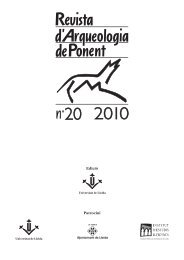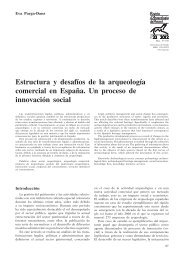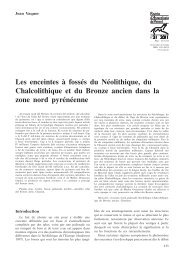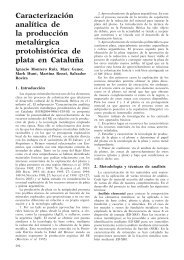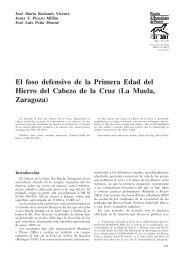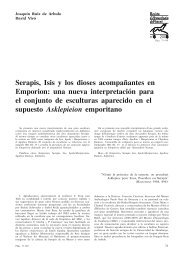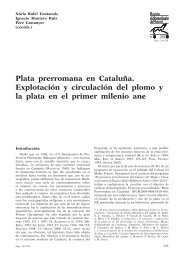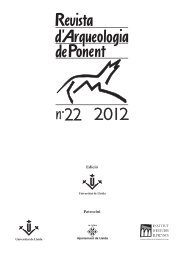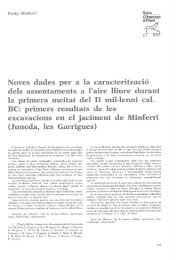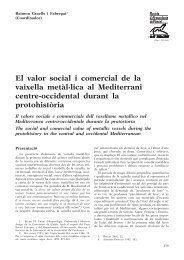RAP 18.1.indd - Revista d'Arqueologia de Ponent
RAP 18.1.indd - Revista d'Arqueologia de Ponent
RAP 18.1.indd - Revista d'Arqueologia de Ponent
You also want an ePaper? Increase the reach of your titles
YUMPU automatically turns print PDFs into web optimized ePapers that Google loves.
Maria Pilar Vàzquez FalipJosep Medina MoralesJoan-Ramon González PérezPàgs. 147-202Les tapadores <strong>de</strong> guix <strong>de</strong> la necròpolisd’incineració <strong>de</strong> la Pedrera (Vallfogona<strong>de</strong> Balaguer-Térmens)La necrópolis <strong>de</strong> campos <strong>de</strong> urnas <strong>de</strong> la Pedrera (Broncefinal-primera edad <strong>de</strong>l hierro-ibérico Antiguo) fue localizada conmotivo <strong>de</strong> unas obras <strong>de</strong> terraplenado en el año 1958. Su historiaha sido <strong>de</strong>safortunada <strong>de</strong>s<strong>de</strong> su localización, con una gran pérdida<strong>de</strong> información dadas las condiciones <strong>de</strong> su hallazgo y si bien sehan dado a conocer algunas <strong>de</strong> sus piezas más relevantes, no seha publicado ninguno <strong>de</strong> los estudios íntegros -tesis <strong>de</strong> licenciatura-realizados (el último <strong>de</strong>l año 1986). A pesar <strong>de</strong> ello es unanecrópolis citada frecuentemente, dadas las singularida<strong>de</strong>s <strong>de</strong> algunosajuares, lamentablemente fuera <strong>de</strong> contexto en su mayoría. Eneste artículo presentamos un conjunto <strong>de</strong> materiales, prácticamenteinédito y sin correspon<strong>de</strong>ncia en ninguna otra necrópolis conocida<strong>de</strong> la zona. Se trata <strong>de</strong> un lote <strong>de</strong> tapa<strong>de</strong>ras <strong>de</strong> yeso, que presentancomo característica relevante, a<strong>de</strong>más <strong>de</strong>l material utilizado ensu fabricación, improntas en su cara inferior, correspondientes atelas y a esteras, que nos ofrecen una información adicional sobremateriales perece<strong>de</strong>ros <strong>de</strong> difícil conservación.Palabras Clave: Valle <strong>de</strong>l Segre, necrópolis incineración, campos<strong>de</strong> urnas, tapa<strong>de</strong>ras, yeso, improntas, tejido, cestería.The urn-field cemetery of La Pedrera (Late Bronze/Early IronAge Iberian) was located during ground-levelling work in 1958.From the very outset, the site’s history has run far from smoothlywith a substantial loss of information due to the conditions inwhich it was discovered, and the fact that, although some of itsmost relevant finds have in<strong>de</strong>ed been reported, none of the integralstudies, <strong>de</strong>gree theses of which the most recent was carriedout in 1986, has been published. The cemetery is however oftencited on the grounds of the peculiarities of some of the discoveredhousehold furnishings, albeit, unfortunately, for the most part, outof context. In the present article, we present a series of hithertounpublished materials that correspond to no other cemetery charteredin the area.The lot consists of plaster lids relevant both for the materialused in their manufacture and the impressions on their lower facecorresponding to cloths and mats, which offers additional informationas to perishable and hard to preserve materials.Key Words: The Segre Valley, cemetery, cremation, urn-fields,lids, plaster, stamps, woven fabric, wickerwork.1. Ubicació i <strong>de</strong>scripcióEl conjunt <strong>de</strong> poblat i necròpolis <strong>de</strong> la Pedrera(Vallfogona <strong>de</strong> Balaguer-Térmens) es troba ubicaten el límit <strong>de</strong>ls termes municipals <strong>de</strong> Vallfogona <strong>de</strong>Balaguer i Térmens a la comarca <strong>de</strong> la Noguera ala partida que dóna nom al jaciment. El poblat sesitua gairebé en la seva totalitat en el terme <strong>de</strong> Vallfogona<strong>de</strong> Balaguer, mentre que la necròpolis ho fagairebé en exclusiva en el terme <strong>de</strong> Térmens (fig. 1),tal com ja reivindicà en el seu dia Juan Mas Mogues(Mo g u e s 1958).Les seves coor<strong>de</strong>na<strong>de</strong>s UTM són: pel poblat, x:316712, y: 4624935 i z: 226,7 m s.n.m. i per la necròpolis,x: 316844, y: 4624654 i z: 220m s.n.m. 11. Cartografia digital <strong>de</strong> l’Institut Cartogràfic <strong>de</strong> Catalunya<strong>de</strong> l’any 2002.Pàgs. 147-202El poblat se situa en un esperó <strong>de</strong> la tercera terrassaquaternària (T3) <strong>de</strong>l marge esquerre <strong>de</strong>l riu Segre,és a dir la situada entre els 18-20 m <strong>de</strong> la llera <strong>de</strong>lriu (Pe ñ a 1988, 15). Per l’est i pel sud està vorejatper un petit barranc, aprofitat avui com a <strong>de</strong>sguàs<strong>de</strong> la segona sèquia <strong>de</strong>l canal d’Urgell, i domina laseva <strong>de</strong>sembocadura al riu principal. Correspon pertant a una ubicació típica que es troba a bastamenten el Baix Segre. 2 Morfològicament seria un tossal2. Article en preparació (<strong>RAP</strong> 19) a partir d’un capítol <strong>de</strong>la tesi doctoral —inacabada— d’un <strong>de</strong>ls signants d’aquest treball,M. P. Vàzquez Falip (dirigida pel catedràtic <strong>de</strong> prehistòriaE. Junyent), on s’estudien les ubicacions <strong>de</strong>ls jaciments <strong>de</strong>l bronzefinal, primera edat <strong>de</strong>l ferro i època ibèrica <strong>de</strong>l Baix Segre enrelació amb la xarxa hidrogràfica principal i secundària i on es<strong>de</strong>staca la importància d’aquesta última en l’estructuració <strong>de</strong>lterritori i els controls d’entrada i sortida d’aquestes valletes i laseva evolució al llarg <strong>de</strong>ls perío<strong>de</strong>s cronològics estudiats.147



